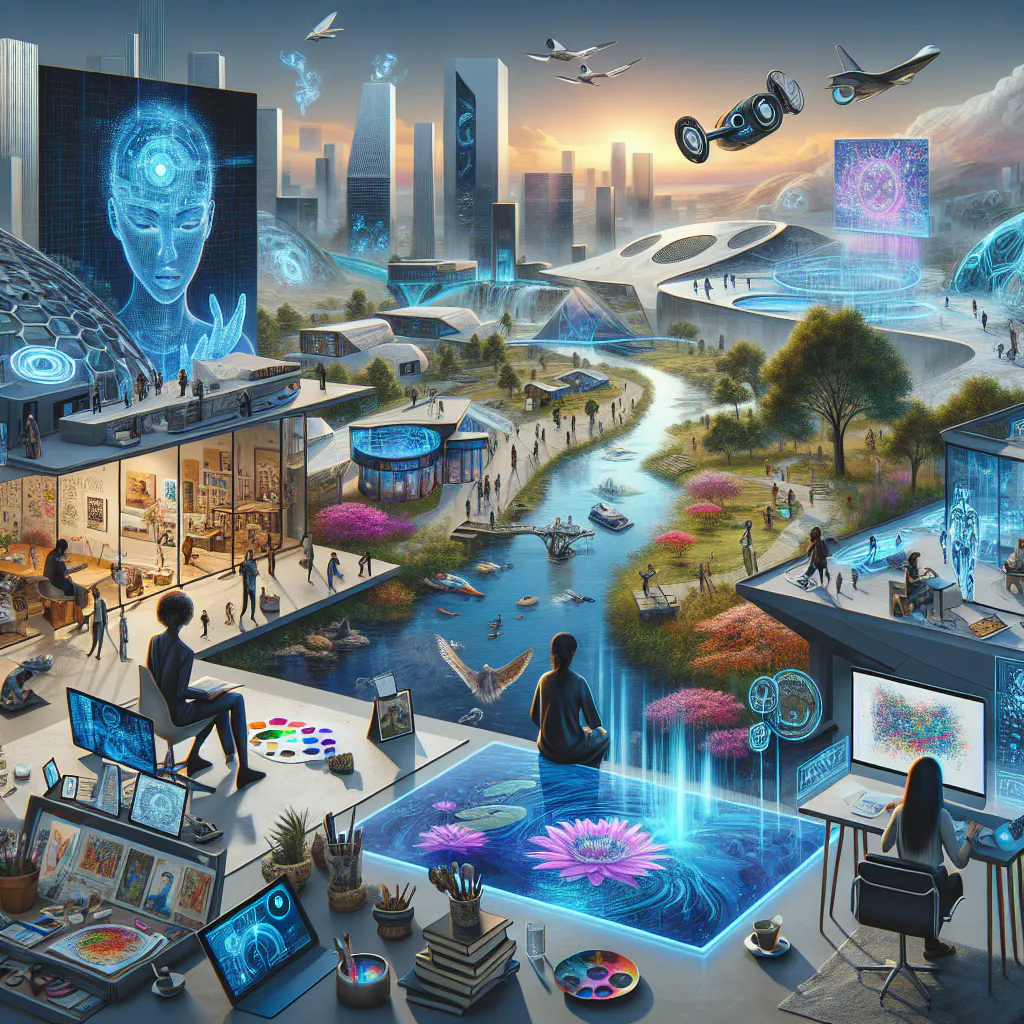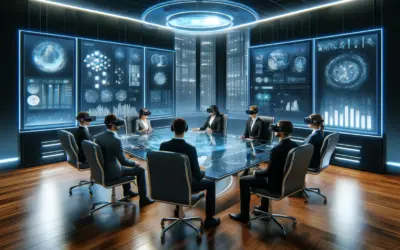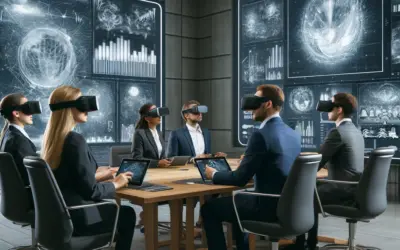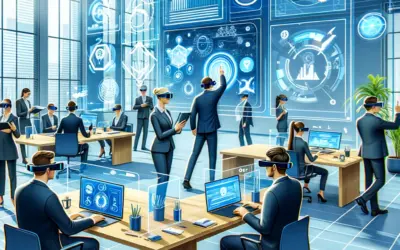The word «metaverse» is a blend of «meta,» meaning beyond, and «universe,» referring to a collective virtual shared space. This concept has been evolving for years but gained remarkable traction recently. It’s often seen as an immersive, digital universe where people can interact, work, and play. In a work context, the metaverse presents a virtual environment that goes beyond video calls and chatrooms. The integration of virtual reality (VR), augmented reality (AR), and artificial intelligence (AI) creates interactive and seemingly tangible workspaces where physical presence is no longer a requirement for collaborative productivity.
The Advantages of Metaverse for Remote Work
Enhanced Collaboration and Interaction
Metaverse work environments offer an exceptional level of interaction among team members. With the use of avatars, workers can participate in realistic meetings, handle virtual objects, and feel more present with their colleagues. This can lead to enhanced collaboration, as being in the same ‘room’ — even virtually — improves communication and brainstorming processes.
Flexible and Customizable Workspaces
The versatility of the metaverse allows employees to customize their workspaces entirely. Unlike the static nature of physical offices or the limitations of screen-based home setups, the metaverse offers endless possibilities to create work environments that cater to personal preferences and productivity requirements. This not only boosts morale but could also lead to a significant increase in employee satisfaction and efficiency.
Challenges Facing Metaverse Work Environments
Technical and Accessibility Barriers
Despite its potential, the metaverse work environment faces several challenges. High-quality VR and AR experiences require sophisticated and sometimes expensive equipment. Not everyone has easy access to the necessary technology, which creates a digital barrier to entry. Moreover, there can be a learning curve associated with navigating these immersive spaces, which may deter some from embracing this next-gen work environment.
Security and Privacy Concerns
When work moves into a virtual space, the threats to security and privacy also evolve. Protecting sensitive information within the metaverse is a concern that businesses must address head-on. While encryption and secure data practices are standard, the novelty of the metaverse requires new protocols to safeguard against cyber threats that could compromise both company and personal data.
The Future of Work: Predictions and Potentials of Metaverse Adoption
The metaverse has the potential to revolutionize how we perceive the concept of ‘workplace.’ It may well become the norm for industries that crave innovation and flexibility. As we see an increase in work-from-home and digital nomadism, the metaverse’s role in our professional lives is anticipated to grow. It fosters not only a global workforce but also enables a level of work-life integration previously unseen, with many predicting that it will lead to healthier work habits and lifestyles. As technology advances and becomes more mainstream, the metaverse work environment is likely to be a significant player in the future world of work.
Navigating the Challenges and Opportunities in Metaverse Workspaces
In the rapidly evolving digital landscape, metaverse workspaces are at the forefront of the next workplace revolution. However, diving into a virtual work environment comes with its unique set of challenges and opportunities. Let’s explore the keys to successfully navigating the metaverse workplaces.
Understanding the Metaverse Infrastructure
The foundation of any metaverse workspace is its infrastructure. A seamless blend of augmented reality (AR), virtual reality (VR), and internet functionality is crucial. This tech trio enables an immersive experience that can enhance collaboration and creativity among remote teams. Businesses venturing into metaverse workplaces must invest in robust hardware and software solutions to support these technologies, ensuring minimal latency and high-quality user interactions.
Overcoming Interoperability Hurdles
Interoperability within the metaverse – the ability for diverse virtual environments and assets to interact – is a significant challenge. For a smooth transition, companies need to focus on compatible systems that allow employees to navigate between different virtual spaces without friction. Ensuring this compatibility enhances the flexibility of work and allows for more dynamic team engagements.
Maximizing Opportunities for Virtual Collaboration
The metaverse opens up exciting avenues for virtual collaboration. With tools such as 3D modeling and real-time simulations, team members can work together in ways that were previously impossible. This could lead to innovations in product development, team training, and project management. By leveraging the capabilities of the metaverse, businesses can create collaborative workspaces that are not only efficient but also engaging and inspirational.
Ensuring User Comfort and Safety
User comfort and safety are paramount. Spending extended periods in VR can lead to discomfort or health concerns. It’s essential for companies to implement usage guidelines, such as regular breaks and ergonomic user interfaces to prevent fatigue. Additionally, robust privacy and security protocols must be in place to protect sensitive information and provide a safe virtual space for users to operate in.
How Metaverse Work Environments are Redefining Remote Collaboration
The evolution of remote work has delivered a paradigm shift from conventional conference calls to immersive, interactive sessions within Metaverse workspaces. These digital realms are sculpting a futuristic landscape for collaboration, where geographical boundaries fade and virtual presence reigns. With real-time communication and 3D interaction, Metaverse environments are turning the tide on remote collaboration. Through intricate virtual setups, employees can now engage with one another in ways that closely mimic physical interaction, despite being miles apart.
Creating a Sense of Presence with Avatars and Digital Workspaces
Within the confines of the Metaverse, avatars serve as personal representatives, allowing users to express themselves and their ideas more naturally. This visual embodiment facilitates non-verbal cues and gestures that are often missing in traditional remote setups. Leveraging cutting-edge technology, such as VR headsets and motion tracking, these avatars can replicate a person’s physical mannerisms, delivering an authentic sense of ‘being there’ within a digital workspace.
Enhancing Real-World Interaction Through Virtual Elements
The integration of virtual components in remote collaboration offers an engaging mix of real-world dynamics and enhanced digital capabilities. From manipulating complex 3D models to brainstorming on a virtual whiteboard, these interactions transcend the limitations of screen sharing and video calls. The metamorphosis from passive participation to active engagement in a shared virtual environment has solidified the core of collective problem solving and project management in the Metaverse.
Networking and Team Building in the Digital Age
Metaverse work environments extend beyond mere meetings and project tasks, they nurture a social dimension akin to physical office spaces. Networking nooks, virtual team-building exercises, and digital lounges are new arenas fostering camaraderie and interpersonal connection among remote teams. These spaces counteract isolation and allow for spontaneous encounters that can lead to innovative thought exchange, just as in-person serendipitous meetings in a physical office would. The Metaverse redefines team dynamics, breaking free from email chains and static chatrooms to offer a substantial setting where professional relationships can thrive.
The Impact of Metaverse Technology on Future Workplace Dynamics
Transforming Communication and Collaboration
As we stand on the brink of the metaverse revolution, the impact on workplace dynamics is poised to be significant. Virtual reality (VR) and augmented reality (AR), the cornerstones of metaverse technology, promise to transform how we communicate and collaborate in professional settings. Imagine logging into a virtual office space from your living room, attending meetings as a 3D avatar, and interacting with colleagues’ avatars from around the globe. This immersive environment enables real-time collaboration that transcends physical boundaries, fostering a sense of presence and community despite geographical disparities.
Revolutionizing Training and Development
Metaverse technology offers unprecedented opportunities for employee training and development. Traditional methods of learning are evolving, and with the metaverse, onboarding new employees or upskilling current teams can happen in interactive virtual worlds. Imagine practicing a complex surgical procedure or conducting a hazardous chemical experiment in a risk-free simulated environment. These hands-on experiences enhance the learning curve, making the acquisition of new skills more engaging and efficient.
Redefining Workplace Flexibility
The shift towards remote work has catalyzed the need for flexible work arrangements. Metaverse technology further redefines workplace flexibility by allowing employees to design their own virtual workspaces. Whether it’s a quiet beachfront office or a replica of a high-powered boardroom, these personalized spaces can boost productivity and well-being. Moreover, the metaverse removes the limitations of physical office space, allowing companies to scale their operations without the constraints of the physical world, leading to cost savings and reduced environmental impact.
Challenges and Considerations
While the benefits are plentiful, the integration of metaverse technology into the workplace also presents challenges. Issues around data privacy, security, and the digital divide must be addressed. Ensuring equitable access to technologies and managing employee health, given the potentially increased screen time, are concerns that businesses must navigate carefully. These considerations are pivotal in creating an inclusive, safe, and efficient future workplace that leverages the full potential of the metaverse.
As we delve into the realm of the metaverse, its technology reshapes not just the future workspace but also the very essence of our professional interactions and day-to-day experiences. The extent of its impact remains to be seen, but one thing is certain—the metaverse is set to play a transformative role in the evolution of workplace dynamics.
Essential Tools and Best Practices for Thriving in a Metaverse Work Setting
As we venture into the age of hi-tech digital workspaces, the Metaverse is becoming an increasingly popular platform for remote work and collaboration. To seamlessly navigate this virtual universe, it is crucial to equip oneself with essential tools and adopt the best practices that ensure productivity, security, and comfort.
Must-Have Metaverse Work Tools
The foundation of any effective Metaverse workplace is robust tools that facilitate communication, project management, and creative expression. Key tools include:
- Virtual Reality (VR) Headsets – A high-quality VR headset is paramount for immersive interaction within the Metaverse, providing a hands-on experience as if you’re in the same room with your colleagues.
- Avatar Customization Software – Professional avatars are the new business attire. Tools that help tailor your digital persona foster personal branding and express individuality.
- Collaborative Platforms – Platforms with features for sharing documents, real-time editing, and virtual meeting spaces streamline workflows and foster collaboration.
- Task Management Software – To keep track of deadlines and deliverables, task management tools are essential, offering clarity and focus in a virtual setting.
Incorporating these essential tools into your Metaverse toolkit will put you on track to excelling in this new work environment.
Best Practices for a Productive Metaverse Workspace
Adopting certain best practices ensures that one not only survives but thrives in the Metaverse. It is important to:
- Set Clear Goals – Begin your virtual workday with a set of achievable goals. Having clear targets helps to maintain focus in the visually and stimulus-rich Metaverse.
- Uphold Netiquette – Respect and professionalism should extend to virtual interactions. Practicing good netiquette preserves a collegial and productive work atmosphere.
- Establish Boundaries – One must define work-life boundaries to prevent burnout. Set work hours and take regular breaks away from your headset to recharge.
- Stay Up-to-Date – The Metaverse is an evolving space. Keeping informed on the latest updates and tools can provide a competitive edge and enhance efficiency.
Balancing the use of advanced tools with mindful best practices guarantees not just survival, but the ability to thrive and innovate in the Metaverse workspace. By staying current, respecting virtual space, and using technology wisely, one can effectively harness the full potential of this exciting new frontier of work.













0 comentarios